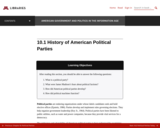
This chapter of a textbook explains political parties and their origins.
- Subject:
- History
- Material Type:
- Reading
- Textbook
- Provider:
- University of Minnesota Libraries
- Author:
- University of Minnesota
- Date Added:
- 06/02/2022

This collection contains highly recommended U.S. Government and Citizenship lessons, activities, and other resources from the eMedia library.

This chapter of a textbook explains political parties and their origins.

Students can answer the quiz questions to see how their political beliefs match their political parties and candidates. The survey questions are balanced, and students can learn more about a topic or pick their on response if the ones listed don't match what they think.
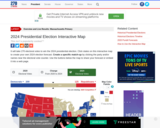
An interactive map that shows electoral college results for presidential elections. Also includes historical elections back to 1789, and various elections for Senate, House of Representatives, and governors. Students can also interactive with and manipulate the map to see how elections would have turned out with different results.

This lesson explores the challenges the United States faced as a result of the terrorist attacks on September 11, 2001, and examines the government's response through the lens of protection and civil liberties. Students will consider the long-term effects of the emergency measures, their consequences and constitutionality, and how they might inform the balance between security and liberty today.

The anniversaries of the terrorist attacks on the United States on September 11, 2001, and the signing of the Constitution on September 17, 1787, provide us an opportunity to reflect upon who we are as Americans, examine our most fundamental values and principles and affirm our commitment to them, and evaluate progress toward the realization of American ideals and propose actions that might narrow the gap between these ideals and reality. The following lessons are designed to accomplish these goals.
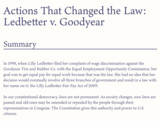
This lesson is based on the Annenberg Classroom video âA Call to Act: Ledbetter v. Goodyear Tire and Rubber Co.,â which tells the law-changing story behind the Lilly Ledbetter Fair Pay Act of 2009. Students gain insight into law-making process, consider how statutory decisions made by the Supreme Court can prompt better laws, and learn about the rights and responsibilities they will have when they enter the workforce.
The estimated time for this lesson is four days.
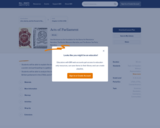
Use this lesson as the foundation for the Stamp Act Resistance Narrative, The Boston Massacre Narrative, and The Boston Tea Party Narrative.

Website that has current news that is sorted by political ideology. Good to use for current event research. You can search a specific current political news story and be able to see how news outlets on the Left, Center, Right describe that topic.

The era of the American Founding lasted from the 1770s through either the late 1780s or early 1790s, depending on one’s perspective or school of thought. For the sake of this resource, the Founding is defined as being the period from 1776 through 1789 – that is, from the writing of the Declaration of Independence through George Washington’s inauguration as the country’s first president. This toolkit provides guiding questions and links to essential documents, resources, and lesson plans related to America's founding.

In 1777, the Second Continental Congress adopted the Articles of Confederation. The objectives of this activity are: Students will analyze the provisions of the Articles of Confederation. Students will determine why individuals such as George Washington expressed a growing concern over government’s inadequacies, and why these concerns were expressed by and heightened after events such as Shays’s Rebellion. Students will explain why there was a growing call for creating a strong central government and the rationales for the various arguments.
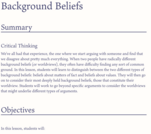
We've all had that experience, the one where we start arguing with someone and find that we disagree about pretty much everything. When two people have radically different background beliefs (or worldviews), they often have difficulty finding any sort of common ground. In this lesson, students will learn to distinguish between the two different types of background beliefs: beliefs about matters of fact and beliefs about values. They will then go on to consider their most deeply held background beliefs, those that constitute their worldview. Students will work to go beyond specific arguments to consider the worldviews that might underlie different types of arguments.
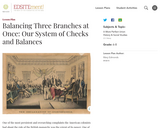
Learn about the checks and balances system of the three branches of the U.S. government.

In this webinar by iCivics and the Center for Civic Education, Henry L. Chambers, Jr., Emma Humphries, and Mike Fassold explain the long and troubled history of voting rights in the United States and share tips for teaching representation and the expansion of suffrage.
Mike Fassold, an educator from Fishers Junior High School in Indiana, explains how he teaches the expansion of voting rights using the We the People middle school curriculum. Fassold is followed by Professor Henry Chambers, the Austin E. Owen Research Scholar & Professor of Law at the University of Richmond, who discusses the 2020 Census, apportionment, and gerrymandering. Finally, Emma Humphries, the Chief Education Officer at iCivics, explores compelling new infographics and Web activities on the census, gerrymandering, and voting that will engage your students.

The first ten amendments to the United States Constitution, adopted through ratification, are collectively referred to as the Bill of Rights. As the first nine outline fundamental guarantees to the citizenry and the tenth reserves some governmental powers to the state governments, the Bill of Rights establishes limitations on the scope of the federal government. In this lesson, students will explore the history of the Bill of Rights and the meaning of the amendments included in the document through videos and activities.

In this lesson, students will learn about the individual rights that are included in the Bill of Rights and current issues relating to them. Students will use C-SPAN Classroom's Constitution Clips to explore what each of these rights mean and determine how these rights apply to current events in America. This lesson works well with classes with one-to-one devices or in flipped classrooms.

The Court decided that state laws requiring separate but equal schools violated the Equal Protection Clause of the 14th Amendment. This resource includes teacher materials, guides, and activities for teaching about this Supreme Court case.
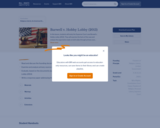
In this lesson, students will study the Supreme Court case Burwell v. Hobby Lobby (2013). They will examine the facts of the case and analyze the arguments made on both sides through primary source documents and preceding cases. They will then assess the majority and minority decisions for the case.
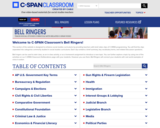
Short video clips designed to complement teaching about the civics, the Constitution, and social studies. See Consitutional Foundation clips onHow Electorial Votes are Counted, SCOTUS' lemon test, Legal Protections for Gun Manufacturers, Internal Fragmentation of Democracies & more. Most topics cover current relevance. To save to your own classroom, you need to create a login (free). Includes many intreviews with historians, making this ideal for history classsrooms.
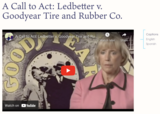
This documentary tells the story of Lilly Ledbetter, whose fight for equal pay for equal work eventually involved all three branches of government. Her U.S. Supreme Court case, Ledbetter v. Goodyear Tire and Rubber Co., turned on the interpretation of the 180-day statute of limitations for filing a discrimination complaint under Title VII of the Civil Rights Act of 1964. After losing at the Supreme Court, Ledbetter urged Congress to start the 180-day clock for filing a complaint on the date an employee learned of the discrimination. The result was the Lilly Ledbetter Fair Pay Act of 2009.
Closed captions available in English and Spanish.

This lesson features an investigation of a selected member of Congress to determine whether they may have been influenced by campaign contributions. The lesson has various videos about the creation of the FEC, court cases dealing with campaign finance, and a lesson plan that has students discuss how campaign funds may influence voting behavior. There are number of different sections to this lesson plan that could each be used as a single part of a lesson plan developed by a teacher.